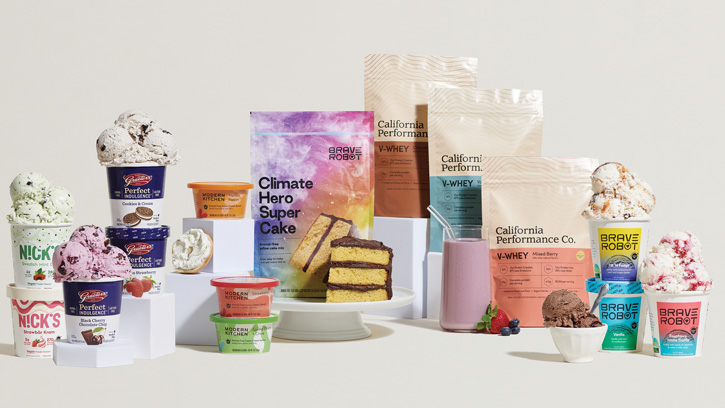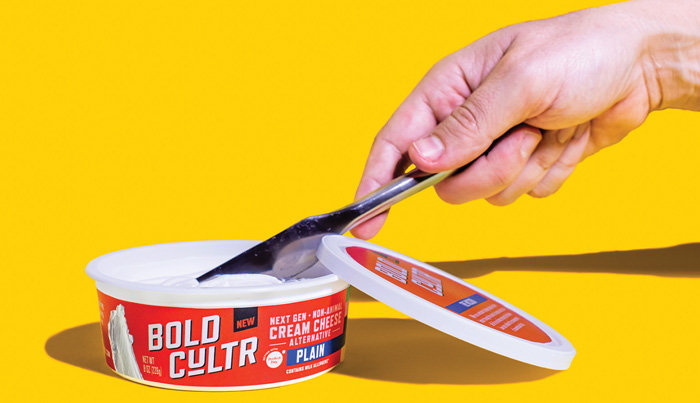Will New Dairy Alternatives Deliver?
Startups & Innovators | INNOVATIONS
Is it important for a “dairy” product to include all of the sensory, functional, and nutritional subtleties of real milk as an ingredient? Or will consumers settle for a facsimile that is built in a lab out of most—but not all—of the components of the liquid you get from a cow?
Consumers will answer this question eventually. In the meantime, the growing “alt-milk” industry is attracting millions of dollars in investments by venture capitalists and others and beginning to churn out ersatz cheeses, cream cheeses, ice creams, and other products that are testing the devotion of dairy adherents. They’re spinning an alluring but unproven narrative about how their approach is far more environmentally sustainable than a dairy production process whose footprint demands vast pastureland, lakes full of water, and hundreds of millions of methane-spewing cows.
Echoing the flurry of fliers that have been taken on scientifically constructed “alt meats” over the past several years, alt-milk investors keep lining up to bet on startups that are using fermentation technology and chemical fractionation of milk to mimic dairy profiles. They believe such products eventually will exceed the tremendous market success already enjoyed by plant-based milk and dairy substitutes, including soy-, almond-, coconut- and cashew-based beverages and analogues of cheeses and yogurts.
“Existing alternatives, as good as they are, aren’t meeting the bar,” says Irina Gerry, chief marketing officer for Change Foods, one of the alt-dairy players. “There are chemical and structural reasons for that, and what you need is [for] dairy proteins to deliver both performance and nutrition.”
The Dairy Perspective
The dairy industry’s reaction to the new alt-milk threat has been measured. Having long battled share-of-stomach incursions from beverage makers, the industry’s emphasis is on making sure consumers don’t mistake alt milk for the real thing.
“We’re not even opposed to its existence,” says Alan Bjerga, senior vice president of communications for the National Milk Producers Federation, about the alt-milk industry. “What we are opposed to is naming practices that create false impressions of equivalence with consumers.”
The biggest alt-milk investments so far include a recent $350 million funding round for Perfect Day, which is supplying several food processors with animal-free whey protein and has fielded its own line of consumer alt-dairy products. Completing a $120 million Series B funding round recently was Remilk, a company based in Tel Aviv, while Imagindairy, another Israeli company, finalized a $13 million seed round. Other players include Change Foods, which has raised more than $3 million.
Meanwhile, General Mills threatens to become the largest alt-dairy player of all. Company researchers developed a cream cheese substitute based on synthesizing whey proteins using precision fermentation, which generates what the company says is “functionally identical protein to that of a cow—but made without the cow.”
The legacy CPG giant started out test marketing Bold Cultr in a single bagel shop in its hometown of Minneapolis. Its target market is “the flexitarian, but not just any flexitarian,” says Drake Ellingboe, co-founder of the Bold Cultr brand. “We’re focused on Gen Z and millennials. Our research has found that they’re very interested in products like Bold Cultr that allow them to move away from animal products but not sacrifice on taste, texture, or function.”
A Tiered Approach
The ladder of dairy alternatives has three tiers, with plant-based “milks” on the first rung. The new alt milks are on the second level, mostly using fermentation methods comparable to microbrewing, and cellular reconstruction of milk is on the highest plane. Gerry says that cell-based reproduction of milk would be “incredibly expensive,” and at this point could be done profitably only by a few startups, such as Biomilq, which is producing an imitation of human breast milk that is expected to retail at a high price point.
Perfect Day focuses on recreating a single protein, beta-lactoglobulin, one of the whey components of milk. “It’s the major component of protein-based nutrition that people are eating when they are eating dairy products,” says Tim Geistlinger, the company’s chief scientific officer. “We use microflora that are really powerhouses in making amino acids and proteins. There’s a fermentation process, and on the back end you have this broth and have to filter out the microbes. Many of these steps are identical to what dairy uses in their purification processes. And then it’s spray-dried.”
The company chose beta-lactoglobulin to produce first “because it’s one that a lot of food companies use,” Geistlinger says. Perfect Day licensed specific strains of bacteria to produce the protein “because these are already good at working at industrial scale.” And now that Perfect Day has proven its concept, he says, “we’ll use that as the foundation for building out our entire program. Now we’re looking at other proteins and mapping that territory as we go.”
Change Foods is among the companies that already have mapped out and replicated more of the components of milk using fermentation. The company has fabricated two caseins of the three in cheese—a pair that comprise almost 90% of any cheese, Gerry says—and is developing its formula into intended commercial products.
“Cheese is the most lagging product in plant-based on its [functional] performance and in satisfying consumer needs,” she says. “Yet it’s the Holy Grail of plant-based food. People will go vegan if it wasn’t for cheese; they love it, and it’s delicious. And the bar for what ‘cheese’ is in people’s minds is really high. Being good enough isn’t enough for the vast majority of people.”
Ellingboe agrees that consumers “want that real-cheese experience but haven’t found a good alternative yet. Our focus is around those looking in the cheese world who’d like to eat non-animal cheese as long as it ‘works for me.’ It’s all around the idea of reducing—the sort of consumer who talks about ‘meatless Mondays’ and using a steel straw instead of a paper one.”
Indeed, strong growth in cheese sales remains the most important dynamic in the dairy market even as butter enjoys a bounce back after decades of misplaced nutritional ignominy, as yogurt sales have plateaued after a decades-long explosion, and as processors continue to attempt to pull fluid milk sales out of their epochal plunge.
Keeping it Real
Dairy companies and farmers have been battling artificial cheeses for a half-century, so others coveting their cheese market isn’t new. In fact, the California dairy industry developed the “Real” seal for dairy packaging in 1976 to combat the use of imitation cheeses on pizza, and soon Real became a national campaign and merchandising icon that persists to this day.
To counter the new alt-milk threat, dairy interests are taking a three-pronged approach. First, they note that no startup has declared it is fermenting proteins that somehow amount to a complete carbon copy of actual milk, explaining that natural dairy contains many micronutrients and molecular interrelationships that still aren’t fully understood.
Second, the dairy industry wants to strengthen naming and labeling practices for all milk-alternative products because consumers already are misled about nutritional equivalence. “Survey data shows people assume that plant-based beverages have as much or more protein than a dairy product when it might be only one-quarter or one-eighth as much,” Bjerga says.
Milk producers aren’t ready to concede the point on sustainability either, having made a net-zero carbon-neutrality commitment for 2050 and complaining that dairy contributions to greenhouse gas emissions are wildly exaggerated.
The dairy business also might be able to take some hope for the fate of alt-milk makers from the troubles of an alt-meat industry that has experienced turbulence upon takeoff. Growth for some companies looks uncertain, and cell-based meat analogues remain mostly in the laboratory for now.
And just as livestock producers do, the dairy industry and its allies point to the importance of milk and dairy production as a pillar of the rural American economy. “Dairy is ultimately the product of a multigenerational family farm,” Bjerga says, “not a VC attempting to profit off a marketing campaign fit to today.”




